Lets explore Chianti...
Chianti; a word everyone recognises in terms of Italian wine, but what does it actually mean?
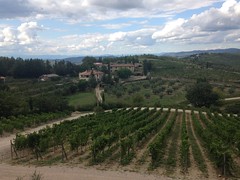
Ok, ok, one of the reasons I'm moving to Florence is the wine.
I'll admit it. Nothing fills me with as much happiness as a great glass of Sangiovese, especially from the Chianti DOCG region. A young fresh fruity wine, full of sour cherries, earthy tannins and a great rich mouthfeel, or enjoy it after a bit of age, adding more savoury, smokey, sweet tobacco notes.
Chianti; a cheap wine in a beautilful round bottomed bottle in a little straw basket, perfect for a candle holder maybe. Not anymore.
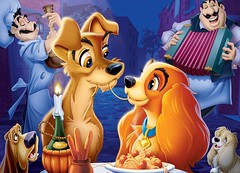
(although I'm totally up for a come-back)
So lets go into Chianti DOCG in a bit more detail;
Chianti is in Tuscany, Central Italy, and the DOCG bit (Denominazione di Origine Controllata e Garantita) is a recognition of quality - the wine has a guaranteed designation of origin, and is pretty easy to enjoy a glass or two.
This region covers all the Chianti wine, even overlaps some other wine areas you may have heard of; Brunello di Montalcino, Vino Noble di Montepulciano and Vernaccia di San Gimignano; I'll go into these areas in more details at the later date. Lets focus just on Chianti DOCG for now:

- A wine from 8 sub-regions; Classico, Colli Aretini, Colli Fiorentini, Colline Pisane, Colli Senesi, Rufina, Montalbano and Montespertoli. These are allowed to affix their name to the wine label, wines simply labeled as Chianti will be a blend from these sub-areas or even use some grapes not within the boundaries of a sub-zone.
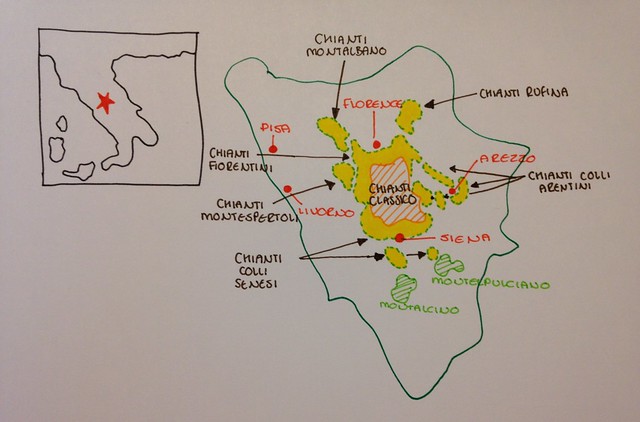
Chianti Classico is of the most importance with its vineyards covering 7,000 hectares, tucked in-between Florence and Siena. Once upgraded to its' DOCG status in 1984 (along with Chianti), the wine kind of re-branded itself; focusing much more on quality, with tighter guidelines. Only wine from this sub-region can boast the black rooster on the seal, known a gallo nero on the seal on the neck of the bottle. This indicates that the producer is a member of the Chianti Classico Consortium.

But wines from this area weren't all about the sangiovese grape, before the 1970s, wine makers were putting quite a bit of their local white grape juice (Malvasia and Trebbiano) into the wine; adjusting the flavours, adding some acidity and freshness, thinning it out, watering it down, making it go a little way longer...Only since 1995 did it actually become legal to produce a Chianti with 100% Sangiovese! For a wine to be labelled Chianti, it now must be at least 85% Sangiovese nowadays.
So what's on the label?
Look out for these terms, which will indicate the level of quality;
Gran Selezione ---> 2.5 years of ageing before release (only Chianti Classico)
Riserva ---> 2 years of ageing before release
Chianti Classico------------->
Chianti Colli Fiorentini----- > 1 year of ageing before release
Chianti Rufina--------------->
Chianti Montespertoli ---> 9 months of ageing before release
Chianti------------------>
Chianti Colli Aretini---->
Chianti Colline Pisane---> 6 months of ageing before release
Chianti Colli Senesi---->
Chianti Montalbano ----->
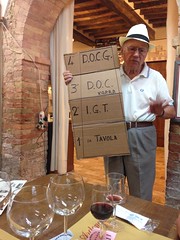
This is a little old winemaker explaining to us the levels of Tavola (table wine), IGT, DOC and DOCG wines.
Some of my favourite producers;
So now onto what you should be drinking, from the large producers, to the wineries making classic wines you can trust, to small boutique wineries, to the new young winemakers doing something a little different the area, here's the names you should be looking out for! I will be writing up on some of these in more detail in the near future to;
Fontodi
Isole e Olena
Bibi Graetz
Barone Ricasoli Castello di Brolio:
Antinori
Capezzana
Sassicaia
Felsina
Querciabella
Bracaia
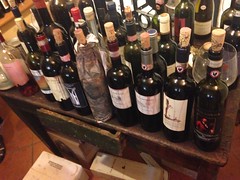
And what should you be tasting?
Chianti Classico are medium bodied wines, with firm and grippy tannins, fairly medium/high acidity with florals flavours, red cherries and some nutty, cinnamon, toasty notes too. With some age, the wine takes on notes of tobacco and leather flavours show. As with all Italian wines, they pair fantastically well with the local produce; think Fiorentina steak, braised boar ragu, crostini di fegato (crouton with liver parfait), maybe just a plate of cured meats and the locally produced Pecorino cheese and of course just on its own is equally as enjoyable.
So buy a bottle, pour a glass and enjoy...

Ok, ok, one of the reasons I'm moving to Florence is the wine.
I'll admit it. Nothing fills me with as much happiness as a great glass of Sangiovese, especially from the Chianti DOCG region. A young fresh fruity wine, full of sour cherries, earthy tannins and a great rich mouthfeel, or enjoy it after a bit of age, adding more savoury, smokey, sweet tobacco notes.
Chianti; a cheap wine in a beautilful round bottomed bottle in a little straw basket, perfect for a candle holder maybe. Not anymore.

(although I'm totally up for a come-back)
So lets go into Chianti DOCG in a bit more detail;
Chianti is in Tuscany, Central Italy, and the DOCG bit (Denominazione di Origine Controllata e Garantita) is a recognition of quality - the wine has a guaranteed designation of origin, and is pretty easy to enjoy a glass or two.
This region covers all the Chianti wine, even overlaps some other wine areas you may have heard of; Brunello di Montalcino, Vino Noble di Montepulciano and Vernaccia di San Gimignano; I'll go into these areas in more details at the later date. Lets focus just on Chianti DOCG for now:

- A wine from 8 sub-regions; Classico, Colli Aretini, Colli Fiorentini, Colline Pisane, Colli Senesi, Rufina, Montalbano and Montespertoli. These are allowed to affix their name to the wine label, wines simply labeled as Chianti will be a blend from these sub-areas or even use some grapes not within the boundaries of a sub-zone.

Chianti Classico is of the most importance with its vineyards covering 7,000 hectares, tucked in-between Florence and Siena. Once upgraded to its' DOCG status in 1984 (along with Chianti), the wine kind of re-branded itself; focusing much more on quality, with tighter guidelines. Only wine from this sub-region can boast the black rooster on the seal, known a gallo nero on the seal on the neck of the bottle. This indicates that the producer is a member of the Chianti Classico Consortium.

But wines from this area weren't all about the sangiovese grape, before the 1970s, wine makers were putting quite a bit of their local white grape juice (Malvasia and Trebbiano) into the wine; adjusting the flavours, adding some acidity and freshness, thinning it out, watering it down, making it go a little way longer...Only since 1995 did it actually become legal to produce a Chianti with 100% Sangiovese! For a wine to be labelled Chianti, it now must be at least 85% Sangiovese nowadays.
So what's on the label?
Look out for these terms, which will indicate the level of quality;
Gran Selezione ---> 2.5 years of ageing before release (only Chianti Classico)
Riserva ---> 2 years of ageing before release
Chianti Classico------------->
Chianti Colli Fiorentini----- > 1 year of ageing before release
Chianti Rufina--------------->
Chianti Montespertoli ---> 9 months of ageing before release
Chianti------------------>
Chianti Colli Aretini---->
Chianti Colline Pisane---> 6 months of ageing before release
Chianti Colli Senesi---->
Chianti Montalbano ----->

This is a little old winemaker explaining to us the levels of Tavola (table wine), IGT, DOC and DOCG wines.
Some of my favourite producers;
So now onto what you should be drinking, from the large producers, to the wineries making classic wines you can trust, to small boutique wineries, to the new young winemakers doing something a little different the area, here's the names you should be looking out for! I will be writing up on some of these in more detail in the near future to;
Fontodi
Isole e Olena
Bibi Graetz
Barone Ricasoli Castello di Brolio:
Antinori
Capezzana
Sassicaia
Felsina
Querciabella
Bracaia

And what should you be tasting?
Chianti Classico are medium bodied wines, with firm and grippy tannins, fairly medium/high acidity with florals flavours, red cherries and some nutty, cinnamon, toasty notes too. With some age, the wine takes on notes of tobacco and leather flavours show. As with all Italian wines, they pair fantastically well with the local produce; think Fiorentina steak, braised boar ragu, crostini di fegato (crouton with liver parfait), maybe just a plate of cured meats and the locally produced Pecorino cheese and of course just on its own is equally as enjoyable.
So buy a bottle, pour a glass and enjoy...

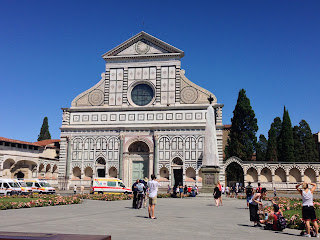
Comments
Post a Comment